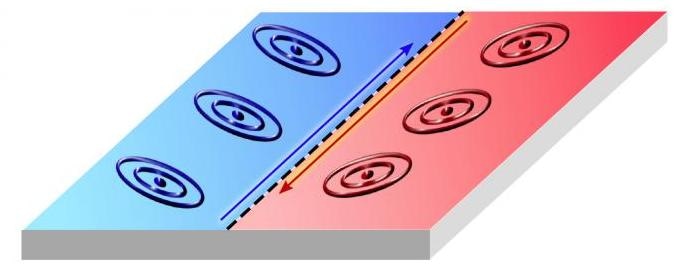Feb 7 2019
Scientists from the Princeton University have established an innovative technique for producing controllable “quantum wires” in the presence of a magnetic field. The new study has been published in Nature.
 This is a schematic of expected conducting lanes where electrons can flow at the boundaries between regions with opposite orientations of electron orbits. (Image credit: Ali Yazdani research group, Princeton University)
This is a schematic of expected conducting lanes where electrons can flow at the boundaries between regions with opposite orientations of electron orbits. (Image credit: Ali Yazdani research group, Princeton University)
The scientists observed channels of conducting electrons that are formed between two quantum states a bismuth crystal’s surface under the influence of a high magnetic field. In these two states, there exist electrons that move in elliptical orbits with distinct orientations.
The researchers were surprised to find that it is possible to turn on and off the flow of current in these channels, thereby transforming these channels into a new type of controllable quantum wire.
These channels are remarkable because they spontaneously form at the boundaries between different quantum states in which electrons collectively align their elliptical orbits. It is exciting to see how the interaction between electrons in the channels strongly dictates whether or not they can conduct.
Ali Yazdani, Director, Princeton Center for Complex Materials
Yazdani is also the Class of 1909 Professor of Physics, who led the research.
A scanning tunneling microscope—a device with the potential to image individual atoms and to map the motion of electrons on the surface of a material—was used by the researchers to visualize the behavior of electrons on the surface of a crystal made of pure bismuth.
The team used this instrument to directly image the motions of the electrons in the presence of a magnetic field that is thousands of times larger than that of a refrigerator magnet. Upon applying the large magnetic field, the electrons are forced to move in elliptical orbits, rather than the more typical flow of electrons parallel to the direction of an electric field.
It was found by the researchers that the conducting channels are formed at the boundary, which they termed as a valley-polarized domain wall, between two regions on the crystal at which the electron orbits suddenly switch orientations.
According to Mallika Randeria, a graduate student in the Department of Physics, who performed the experiments, “We find that there are two-lane and four-lane channels in which the electrons can flow, depending on the precise value of the magnetic field.” She and her team detected that upon tuning the electrons to move in a four-lane channel, they get stuck; however, they can flow unhampered upon being confined to only a two-lane channel.
While attempting to perceive this behavior, the scientists unearthed new rules by which the repulsion between electrons in multi-channel quantum wires is dictated by the laws of quantum mechanics. Although a larger number of lanes translate to better conductivity, the repulsion between electrons causes them to switch lanes, change direction, and get stuck contrary to the predictions, thus leading to insulating behavior. When the number of channels is less, electrons have no choice but to change lanes and have to transmit electrical current even if they have to move “through” each other—a quantum phenomenon possible only in one-dimensional channels such as these.
Analogous protected conduction takes place along the boundaries of purported topological states of matter—the subject of the 2016 Nobel Prize awarded to Princeton’s F. Duncan Haldane, the Sherman Fairchild University Professor of Physics. The theoretical interpretation for the new discovery is based on earlier research performed by two members of the team, Siddharth Parameswaran, who was then a graduate student at Princeton and is currently an associate professor of physics at Oxford University, and Princeton’s Shivaji Sondhi, professor of physics, and their colleagues.
Although some of the theoretical ideas we used have been around for a while, it’s still a challenge to see how they fit together to explain an actual experiment, and a real thrill when that happens. This is a perfect example of how experiment and theory work in tandem: Without the new experimental data we would never have revisited our theory, and without the new theory it would have been difficult to understand the experiments.
Siddharth Parameswaran, Associate Professor of Physics, Oxford University